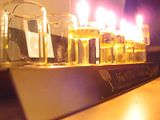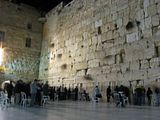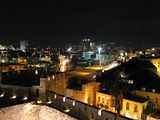A blog about making beer that got ridiculously out of hand
A quick side note - this post got REALLY long as I wrote it, so don't feel obligated to read it!
--------
Okay, so I haven't posted in awhile. A long while. Recently, though, my friend and fellow Pardes Educator Marc Silberstein and I decided to start brewing our own beer.
I've been interested in homebrewing for a few years, but since living in Israel, the prospect of starting up has been quite daunting - on a student's budget, it's pretty expensive in the States, but with everything beer-related being imported, costs here go up even further. After deciding to stay in Israel for a couple more years, though, I couldn't let any more time pass before I started brewing.
At the Jerusalem Wine Festival, I met Denny Neilson, proprietor of The Winemaker, a wine- and beer-making shop in Mevasseret, a town just outside of Jerusalem. I took a two-part, six-hour beer making course, and after that, Marc and I purchased all the start-up equipment needed for our first homebrew.
Before getting into the specifics of our venture, I thought I'd go over the basics of beer making.
To make beer, you basically need three ingredients - water, yeast, and malted grain. Nowadays, beer is rarely brewed without the addition of hops, but until several hundred years ago, hops were rarely added. First, you need to created a 'wort', which is basically water mixed with the sugars extracted from a few kilograms of malted grain. There are several ways to reach a full wort, which I will go over in a bit. After establishing your wort, one usually boils the wort with hops, the flowers from the hop plant which contain bitter oils, in order to add bitterness, flavor, and aroma. Finally, after straining and cooling the wort, yeast is added, before the entire mix is sealed for fermentation. The yeast will then consume the majority of the sugars extracted into the wort, changing all those sugars into alcohol. After several weeks of fermentation and several more weeks conditioning in bottles, the beer is ready to pour.
I mentioned that there are several methods for establishing the wort.
ALL-GRAIN: The most common amongst serious homebrewers is called "all-grain" brewing. In this method, you have to "mash" a mixture of base malts (usually 7-14 pounds) and specialty or flavoring malts (in much smaller quantities, up to 1 pound each, usually), keeping this grain mixture at 65-70 C for 30-60 minutes, depending on the recipe. This method requires the most equipment and the most time, but it is also the cheapest to produce.
PARTIAL MASH: This method requires far less equipment than all-grain, but it is more costly. Essentially, you start by making a "mini-mash", mashing all of the specialty grains and only a portion of the base malt. This mash also occurs in a much smaller quantity of water. After that, you add "malt extract," which comes either dry or liquid, which is essentially as it sounds - concentrated malt extract. Essentially, to save time and space, you are paying someone else to provide you with a whole bunch of the mashing ground work, and you save yourself having to have a much more complicated rig. After adding the malt extract, you continue very similarly to the AG method.
EXTRACT PLUS GRAIN: Very similar to the partial mash, except you don't do a mash at all. Instead, you steep ONLY your specialty grains, replacing all of your base malt with extract. From there, the method is identical to partial mash.
FULL EXTRACT: This method eliminates all grain extraction. Usually, full extract kits come in cans, and in the extract is both the base malt extract and the specialty malt extract. This method is the most expensive but also the easiest. Alas, because you are essentially adding extract to water and boiling, there is little to no variation that can be done with the recipe.
On to our project!
(I'm sorry ahead of time, I tried to take pictures along the way, but at the more labor-intensive parts of the process, I simply forgot. Next brew, I'll try to get more of the process captured)
Because of space limitations and the high start-up cost, we decided to pursue the partial-mash/extract plus grain route. For this method, we only need one large pot (holding roughly 12-16 liters) and a kitchen stove, plus all the fermentation equipment.
Here are our ingredients (plus a couple of beers to drink along the way):

First, we heated 6 liters of water to 70 C. This recipe is for 19 liters of beer, but the remainder of the water will be added later.

Once the water hit 70 C, we turned off the heat, added the specialty grains tied up in a muslin sack, and covered the pot. At the same time, we placed the liquid malt extract container (in the upper right hand of the picture) in a pot of warm water to soften. Much like molasses or honey, it's very high in sugar, so when cool, is very firm.

While this is steeping, it's a great time to enjoy a beer.

After 30 minutes of steeping, we removed the specialty grains from the water. We threw these grains out, but they could be used in breads, bird feed, or compost. Just don't feed them to your dog - evidently, spent grains are highly toxic. Weird.

Now, we brought the wort up to a boil. So as to prevent burning on the bottom of the pot (from all the sugars in the liquid extract), we turned off the heat. Then, we poured the malt extract into the wort.

Finally, we brought the wort back up to a boil. Once we got a good boil going, we added the "bittering hops". The oils in hops provide different attributes when added at different times - if boiled for awhile, the hops provide bitterness. If boiled only a couple minutes, the hops add flavor. If not boiled at all, but instead added after the boil finishes, the hops add aroma. The recipe we used called for a good amount of hops, which you can see floating on the top of the wort. For a beerhead like myself, things are starting to smell pretty great at this point.

Here's Marc doing his stir thing:

After 60 minutes of boiling, we cut the heat. At this point, it is very important to chill the water as quickly as possible. From this point forward, everything must be sanitized - introducing bacteria at any point here would be very bad. Since bacteria like luke-warm substances, it's essential to get this 90+ C liquid down to a temperature at which the yeast can be added, so that you can seal the mixture and allow fermentation to safely begin. There are several ways to chill this liquid quickly - putting the cook pot in a large sink filled with ice water, immersing a coil cooler into the wort, or our method. We added a large, pre-frozen ice cube (think ice cream tub sized) into the wort in the pot, bringing the temperature down to about 50 C. After that, we added pre-chilled water into the primary fermenter (a large, 25 L bucket), then strained the wort to remove most of the spent hops. At this point, we the topped up the wort to 19 liters with more chilled water, bringing the final beer mix to about 24 C.
I missed taking pictures through most of this, since we were both pretty active, but here are the spent hops:

Finally, we "pitched" the yeast, which basically means adding the yeast to the beer. There are several ways to do this. First, you can start with liquid yeast, which is already active before it's added, but needs to stay refrigerated right up to use. Next, you can rehydrate and activate dry yeast, then add that mix to the beer. Finally, you can do what we did, which is sprinkle the dry yeast directly onto the beer, letting it reactivate in the beer itself. While some brewers don't like this method, it seems to be working for me (and many others who do it this way).
Now, on to fermentation, where I'm at now. Because of the heat in Jerusalem, I had to devise a way to keep the beer cool (ideally, between 16-20 C) without blasting the all-too-expensive air conditioning all day, despite it being 32 C outside. So, I created a "swamp cooler," placing the fermentation bucket in a bin filled with water, adding water bottles filled with water and frozen, wrapping a towel around the bucket (to pull cold water up and around the whole bucket and to keep light out), and aiming a fan at the bucket. (The fermenter is on the left)

So, that's where I'm at. Fermentation started last night, and primary fermentation will continue for the next few days. After that, I'll be transferring the beer to a secondary fermenter for another week or two, then bottling. If there is interest, I can update my progress as I go.
Oh, and here's an early mock-up of the label:

I hope I haven't just bored the tears out of you.
For those that are interested (which is probably none of you), here is the recipe for the first batch:
------------------------
Big Papa Pale Ale
6.6 lb Munton's Super Light Liquid Malt Extract
1 lb Munton's Extra Light Dry ME
1 lb Cara Munich II (50L)
5 oz Cara Aroma
2 oz Cara Amber
4 oz Centennial Hops (9.5% AAU)
3 oz Perle Hops (7.5% AAU)
11.5 g Safale S-05 American Pale Ale yeast
1 tsp Irish Moss
1/4 lb Corn Sugar
Steep specialty malts at 70 C for 30 minutes. Bring wort to boil, add LME and DME. Boil 60 minutes, add hops at following schedule:
60 min - 1 oz. Centennial
30 min - 1 oz. Perle
15 min - 1 oz. Centennial
5 min - 1 oz. Centennial, .5 oz Perle
Dry hop - 1 oz. Centennial, 1.5 oz Perle
Add Irish moss at 15 minutes. Pitch yeast dry, or reactivate in boiled and cooled water. Reserve corn sugar for bottling.









